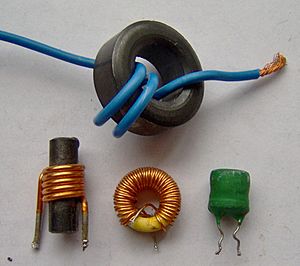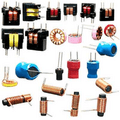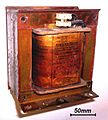Inductor facts for kids
An inductor is an electrical part used in electrical circuits. It works because of how magnetism and electricity are connected.
Inductors are usually made from a coil of conducting material, like copper wire. This wire is often wrapped around a core which can be air or a magnetic metal. Using a magnetic core helps to focus the magnetic field, making the inductor work better. Small inductors can even be built into integrated circuits, similar to how transistors are made. For these tiny inductors, aluminum is often used as the conducting material.
Contents
What Inductors Do
An inductor is like a "traffic cop" for electricity. While a capacitor tries to stop sudden changes in voltage, an inductor tries to stop sudden changes in the electric current flowing through it.
Imagine you have a garden hose. If you suddenly turn the water on or off, the water pressure changes quickly. An inductor acts like something that resists these quick changes in the flow of electricity. It wants the current to stay steady.
How Inductors Are Used
Inductors are very common in analog circuits. When two or more inductors are placed close enough for their magnetic fields to interact, they can form a transformer. Transformers are super important! They are used in every power grid around the world to change voltage levels, making sure electricity can travel long distances and then be safely used in homes.
Inductors are also used in large electrical systems. They can help to lower the amount of voltage an electrical device receives or reduce a sudden surge of current. Because inductors can be quite heavy compared to other electrical parts, engineers are always looking for ways to make them smaller and lighter.
Inductors with an iron core are often found in audio equipment, power systems, and industrial power supplies.
Self-Inductance Explained
You don't always need two separate coils to see how inductors work. Even a single coil of wire carrying an electric current creates its own magnetic field. This magnetic field then creates a "magnetic flux" (think of it as the amount of magnetic field passing through the coil).
This magnetic flux is directly related to the amount of current flowing through the coil. We call this relationship "self-inductance." It's a measure of how much a coil resists changes in its own current. Self-inductance is measured in units called "henries." It depends only on the shape of the coil and how many turns of wire it has, not on the current itself.
If the current flowing through the coil changes, the magnetic flux also changes. According to Faraday's law of induction, this changing magnetic flux creates a voltage (called an "electromotive force" or EMF) across the coil. This voltage always acts to oppose the change in current. So, if the current is increasing, the inductor creates a voltage that tries to reduce it. If the current is decreasing, it creates a voltage that tries to increase it. This is why inductors "don't like changes in current."
For example, a long coil called a "solenoid" has a certain self-inductance. This value depends on its length, its cross-sectional area, and the number of turns of wire. Engineers often use inductors as one of the four basic parts in electrical circuits, along with voltage sources, resistors, and capacitors.
Related pages
- Magnetic charge
- Transformer
- Coil
- Resistor
- Capacitor
- Magnetic core
- Induction coil
- Induction loop
Images for kids
-
A "roller coil," which is an adjustable air-core RF inductor. It's used in the tuned circuits of radio transmitters.
See also
 In Spanish: Inductor para niños
In Spanish: Inductor para niños








